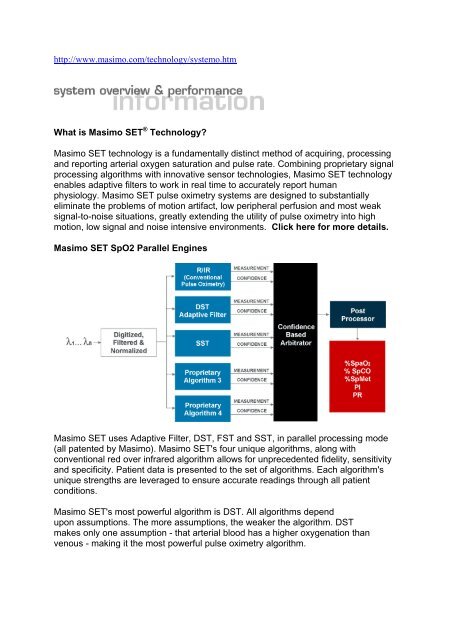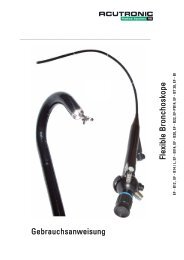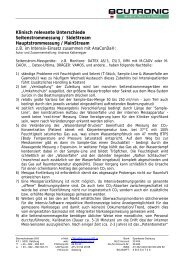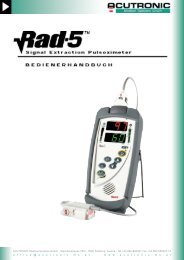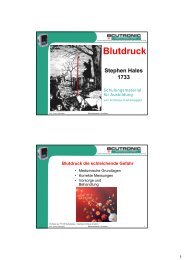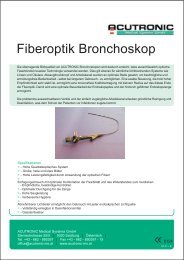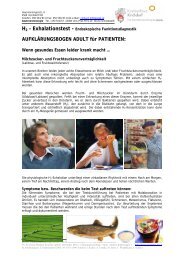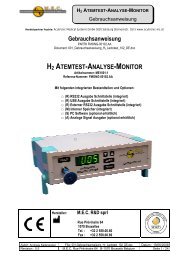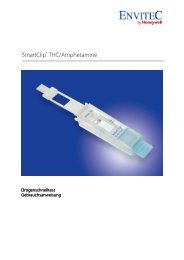http://www.masimo.com/technology/systemo.htm What is Masimo ...
http://www.masimo.com/technology/systemo.htm What is Masimo ...
http://www.masimo.com/technology/systemo.htm What is Masimo ...
Create successful ePaper yourself
Turn your PDF publications into a flip-book with our unique Google optimized e-Paper software.
<strong>http</strong>://<strong>www</strong>.<strong>masimo</strong>.<strong>com</strong>/<strong>technology</strong>/<strong>systemo</strong>.<strong>htm</strong><br />
<strong>What</strong> <strong>is</strong> <strong>Masimo</strong> SET ® Technology?<br />
<strong>Masimo</strong> SET <strong>technology</strong> <strong>is</strong> a fundamentally d<strong>is</strong>tinct method of acquiring, processing<br />
and reporting arterial oxygen saturation and pulse rate. Combining proprietary signal<br />
processing algorithms with innovative sensor technologies, <strong>Masimo</strong> SET <strong>technology</strong><br />
enables adaptive filters to work in real time to accurately report human<br />
physiology. <strong>Masimo</strong> SET pulse oximetry systems are designed to substantially<br />
eliminate the problems of motion artifact, low peripheral perfusion and most weak<br />
signal-to-no<strong>is</strong>e situations, greatly extending the utility of pulse oximetry into high<br />
motion, low signal and no<strong>is</strong>e intensive environments. Click here for more details.<br />
<strong>Masimo</strong> SET SpO2 Parallel Engines<br />
<strong>Masimo</strong> SET uses Adaptive Filter, DST, FST and SST, in parallel processing mode<br />
(all patented by <strong>Masimo</strong>). <strong>Masimo</strong> SET's four unique algorithms, along with<br />
conventional red over infrared algorithm allows for unprecedented fidelity, sensitivity<br />
and specificity. Patient data <strong>is</strong> presented to the set of algorithms. Each algorithm's<br />
unique strengths are leveraged to ensure accurate readings through all patient<br />
conditions.<br />
<strong>Masimo</strong> SET's most powerful algorithm <strong>is</strong> DST. All algorithms depend<br />
upon assumptions. The more assumptions, the weaker the algorithm. DST<br />
makes only one assumption - that arterial blood has a higher oxygenation than<br />
venous - making it the most powerful pulse oximetry algorithm.
<strong>http</strong>://<strong>www</strong>.<strong>masimo</strong>.<strong>com</strong>/<strong>technology</strong>/testresu.<strong>htm</strong><br />
Click here for more<br />
information on DST<br />
<strong>Masimo</strong> SET ® has been validated by over 50 publ<strong>is</strong>hed clinical studies since 1994.<br />
The following are the results of the latest studies.<br />
Motion and Low Perfusion Study<br />
Oximeter<br />
SpO2<br />
Sensitivity<br />
SpO2<br />
Specificity<br />
SpO2<br />
Performance<br />
Index<br />
Drop Out<br />
99% 97% 93% 0.0%<br />
Philips/HP CMS B.0 70% 83% 80% 3.7%<br />
Nellcor N-395 70% 73% 73% 4.0%<br />
Datex-Ohmeda 3900 60% 52% 68% 1.0%<br />
Novametrix MARS 40% 42% 58% 2.4%<br />
Nellcor N-295 39% 53% 55% 7.8%<br />
Barker SJ. Anesthesia and Analgesia 2002;94(S1):S17-21.<br />
Pulse Oximeter ROC(Receiver Operating Character<strong>is</strong>tic) Curves:
<strong>Masimo</strong> SET versus other new generation pulse oximeters:<br />
Hay WW, et al. Hot Topics in Neonatology 2001, Washington DC, 12/9-11/2001
Desaturation Test With <strong>Masimo</strong> SET vs. Nellcor N-3000 (Ox<strong>is</strong>mart) and N-200:<br />
<strong>http</strong>://<strong>www</strong>.<strong>masimo</strong>.<strong>com</strong>/<strong>technology</strong>/qa.<strong>htm</strong><br />
Test Protocol:<br />
Right hand <strong>is</strong> "test"; undergoing motion<br />
Left hand <strong>is</strong> "control"; held still through<br />
test sequence<br />
Saturation and pulse rate data<br />
recorded during indicated<br />
motions. Arterial desaturations to<br />
approximately 80% induced via<br />
breathing reduced FiO2 levels.<br />
• <strong>What</strong> <strong>is</strong> so different about <strong>Masimo</strong> SET <strong>technology</strong>?<br />
• With <strong>Masimo</strong> SET <strong>technology</strong>, <strong>is</strong> the performance enhancement due to the LNOP<br />
sensor design or the <strong>Masimo</strong> SET Algorithms?<br />
• <strong>What</strong> <strong>is</strong> the white "bump" on the LNOP sensors?<br />
• Can the <strong>Masimo</strong> SET system be utilized in high ambient light conditions?<br />
• Does <strong>Masimo</strong> SET <strong>technology</strong> provide improved performance in patients with poor<br />
perfusion or who are otherw<strong>is</strong>e vasoconstricted?
<strong>What</strong> <strong>is</strong> so different about <strong>Masimo</strong> SET <strong>technology</strong>?<br />
<strong>Masimo</strong> SET ® <strong>technology</strong> <strong>is</strong> a fundamentally d<strong>is</strong>tinct method of acquiring, processing<br />
and reporting arterial oxygen saturation and pulse rate. The <strong>technology</strong> represents a<br />
"novel" and "unique" method for calculating the appropriate no<strong>is</strong>e reference in the<br />
detected red and infrared signals thus enabling the use of an adaptive no<strong>is</strong>e canceller to<br />
remove the no<strong>is</strong>e <strong>com</strong>ponents. Th<strong>is</strong> approach <strong>is</strong> fundamentally different from a<br />
conventional "red over infrared" approach and results in significant performance<br />
enhancements unmatched by conventional pulse oximetry systems. A more detailed<br />
description of the <strong>Masimo</strong> SET algorithm <strong>is</strong> contained in Technical Bulletin #1 Pulse<br />
Oximetry Algorithm.<br />
With <strong>Masimo</strong> SET <strong>technology</strong>, <strong>is</strong> the performance enhancement due to the LNOP<br />
sensor design or the <strong>Masimo</strong> SET algorithms?<br />
While there <strong>is</strong> no specific data to determine the relative contribution between the sensor<br />
design and algorithm performance, <strong>Masimo</strong> feels that approximately 50%-75% of the<br />
overall benefit <strong>is</strong> due to the signal processing algorithms with the remaining 25%-50%<br />
attributable to the LNOP sensor design.<br />
<strong>What</strong> <strong>is</strong> the white "bump" on the LNOP sensor?<br />
TThe <strong>Masimo</strong> LNOP family of sensors are designed to significantly reduce the front end<br />
no<strong>is</strong>e contribution from routine patient movements, electromagnetic interference, and<br />
ambient light. The white bump on the sensor incorporates the LNOP cavity allowing the<br />
photo-detector to be recessed away from the soft t<strong>is</strong>sue of the finger, thereby stabilizing<br />
the optical path length between the LED emitters and the photo-detectors during routing<br />
patient motion. A more conventional configuration, with the detector tightly attached to<br />
the soft t<strong>is</strong>sue of the finger <strong>is</strong> more susceptible to motion induced "no<strong>is</strong>e" due to a<br />
mechanical change in the optical path length.<br />
Can the <strong>Masimo</strong> SET system be utilized in high ambient light conditions?<br />
The recessed LNOP photo detector, in <strong>com</strong>bination with <strong>Masimo</strong>'s proprietary signal<br />
processing algorithms, <strong>is</strong> designed to improve system performance in high ambient light<br />
conditions such as those encountered in the NICU, OR or even use in direct sunlight.<br />
Does <strong>Masimo</strong> SET <strong>technology</strong> provide improved performance in patients with poor<br />
perfusion or who are otherw<strong>is</strong>e vasoconstricted?<br />
The <strong>Masimo</strong> SET system (both signal processing and sensors) <strong>is</strong> designed to<br />
be able to monitor extremely weak peripheral pulses which in many instances<br />
are smaller than those capable of being acquired or processed by conventional<br />
pulse oximeter systems. Th<strong>is</strong> <strong>is</strong> ac<strong>com</strong>pl<strong>is</strong>hed through the unique nature of the<br />
<strong>Masimo</strong> SET algorithm and sensor design which <strong>is</strong> capable of separating the<br />
signal from the no<strong>is</strong>e prior to calculating the physiologic measurement.


